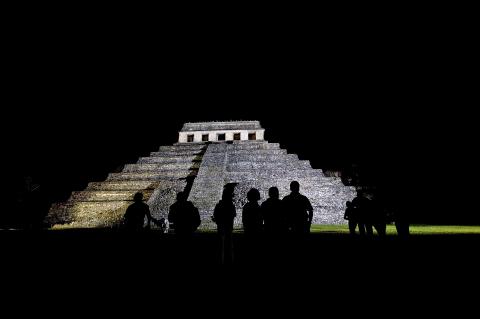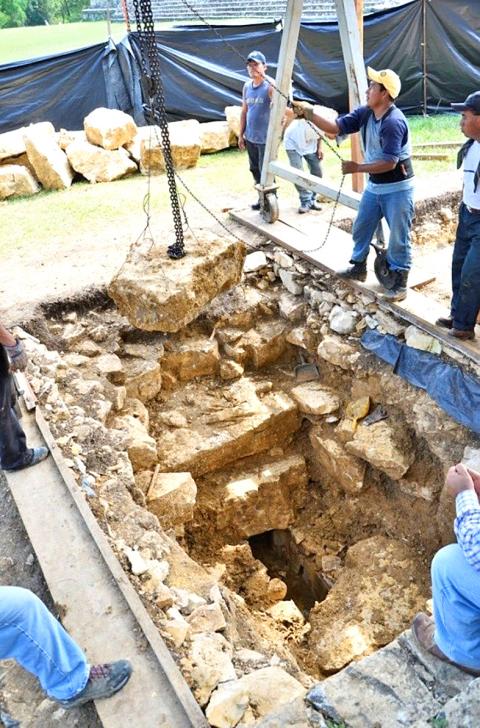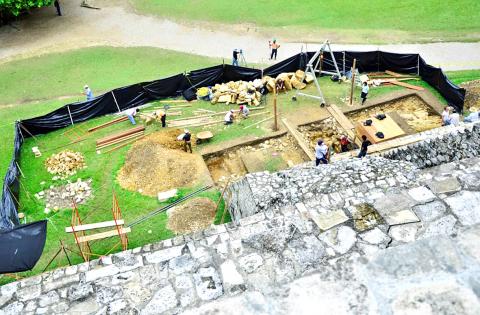Archaeologists at the Mayan ruin site of Palenque said last week that they have discovered an underground water tunnel built under the Temple of Inscriptions, which houses the tomb of an ancient ruler named Pakal.
Archaeologist Arnoldo Gonzalez said researchers believe the tomb and pyramid were purposely built atop a spring between AD 683 and 702. The tunnel led water from under the funeral chamber out into the broad esplanade in front of the temple, thus giving Pakal’s spirit a path to the underworld.
Attention has focused on the heavily carved stone sarcophagus in which Pakal was buried, and which some erroneously believe depict the Maya ruler seated at the controls of a spaceship.

Photo: AP / Alexandre Meneghin
But Gonzalez said carvings on a pair of stone ear plugs found in the grave say a god “will guide the dead toward the underworld, by submerging (them) into the water so they will be received there.”
Pakal, in other words, didn’t fly off into space; he went down the drain.
“There is nothing to do with spaceships,” Gonzalez said.

Photo: AFP/INAH
The tunnel, which connects to another, is made of stone and is about 60cm wide and tall.
The director of archaeology for the National Institute of Anthropology and History (INAH), Pedro Sanchez Nava, said the theory makes sense in light of other pre-Hispanic peoples, such as those who lived at Teotihuacan, near Mexico City, where another water tunnel was found.
“In both cases there was a water current present,” said Sanchez Nava. “There is this allegorical meaning for water ... where the cycle of life begins and ends.”

Photo: EPA/INAH
The dig began in 2012, when researchers become concerned about underground anomalies detected with geo-radar under the area in front of the pyramid’s steps.
Fearing a hole or geological fault that could cause the pyramid to settle or collapse, they dug at the spot — and uncovered three layers of carefully fitted stone covering the top of the tunnel.
Gonzalez said the same type of three-layered stone covering has been found in the floor of Pakal’s tomb, within the pyramid.
He said there appears to be no shaft or connection between the tomb and the tunnel, but adds the conduit hasn’t been fully explored yet because it is too small to crawl through.
Researchers had to send a robot with a camera down to view much of the underground horizontal shaft.
Francisco Estrada-Belli, an assistant professor of archaeology at Boston University who was not involved in the dig, wrote, “I believe that building a tomb over a canal certainly does fit with the belief that water and water bodies were entrances to the underworld.”
“Several cases of temples (and the associated tombs) are known to be built over natural caves that may or may not have held water,” Estrada-Belli wrote.
Author Erich von Daniken suggested in his 1968 book Chariots of the Gods? that Pakal’s stance in the engraving on the stone sarcophagus lid resembled the position of astronauts and that he appeared to be seated in a contraption with flames coming out of it and controls.
Experts say that the “flames” are in fact depictions of the Maya’s “World Tree” or “Tree of Life,” whose roots were believed to reach into the underworld.

The canonical shot of an East Asian city is a night skyline studded with towering apartment and office buildings, bright with neon and plastic signage, a landscape of energy and modernity. Another classic image is the same city seen from above, in which identical apartment towers march across the city, spilling out over nearby geography, like stylized soldiers colonizing new territory in a board game. Densely populated dynamic conurbations of money, technological innovation and convenience, it is hard to see the cities of East Asia as what they truly are: necropolises. Why is this? The East Asian development model, with

June 16 to June 22 The following flyer appeared on the streets of Hsinchu on June 12, 1895: “Taipei has already fallen to the Japanese barbarians, who have brought great misery to our land and people. We heard that the Japanese occupiers will tax our gardens, our houses, our bodies, and even our chickens, dogs, cows and pigs. They wear their hair wild, carve their teeth, tattoo their foreheads, wear strange clothes and speak a strange language. How can we be ruled by such people?” Posted by civilian militia leader Wu Tang-hsing (吳湯興), it was a call to arms to retake

This is a deeply unsettling period in Taiwan. Uncertainties are everywhere while everyone waits for a small army of other shoes to drop on nearly every front. During challenging times, interesting political changes can happen, yet all three major political parties are beset with scandals, strife and self-inflicted wounds. As the ruling party, the Democratic Progressive Party (DPP) is held accountable for not only the challenges to the party, but also the nation. Taiwan is geopolitically and economically under threat. Domestically, the administration is under siege by the opposition-controlled legislature and growing discontent with what opponents characterize as arrogant, autocratic

Desperate dads meet in car parks to exchange packets; exhausted parents slip it into their kids’ drinks; families wait months for prescriptions buy it “off label.” But is it worth the risk? “The first time I gave him a gummy, I thought, ‘Oh my God, have I killed him?’ He just passed out in front of the TV. That never happens.” Jen remembers giving her son, David, six, melatonin to help him sleep. She got them from a friend, a pediatrician who gave them to her own child. “It was sort of hilarious. She had half a tub of gummies,